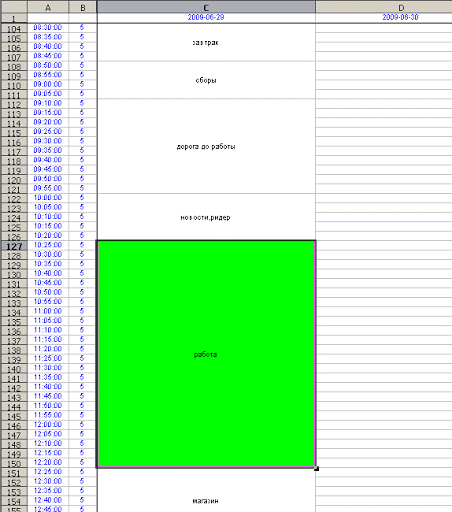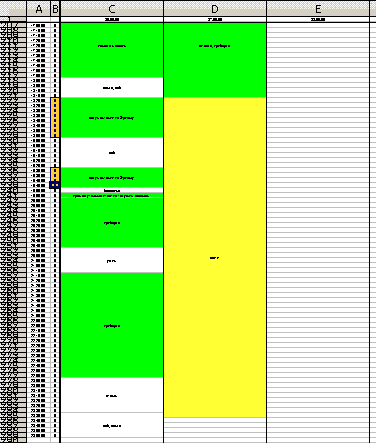A couple of notes about personal logs
After reading the article “Personal Logs Increase Productivity” , I had a desire to supplement it a little, since for some time I have been using these same “personal logs” in order to catch up at those moments when motivation for various reasons begins to weaken. Well, along with motivation, the intensity of working capacity decreases sharply, as a result of which you begin to toil all sorts of nonsense, and at the end of the day you feel tired, but have not done anything useful for the day.
Those who start logging quickly come to the need to upgrade the technique. But why reinvent the wheel again?
In general, for starters, I would recommend reading Daniel Granin’s book “This Strange Life” (it’s short, don’t be lazy, read) - labor that has already become, to some extent, a classic time management. This book tells about the life and work of Alexander Alexandrovich Lyubishchev - the man who led these logs for 56 years of his life, and with their help achieved great efficiency in his own work. But this is not about him now. So, Lyubishchev brought his system to mind for more than a dozen years, so it’s a sin not to take advantage of his achievements. However, while we are not talking about the creation of monumental works, so for myself I use a very simplified version of the system.
First of all, let’s determine why such a system is needed. And it is needed in order to clearly see how time is being spent. After all, you cannot control what you cannot measure and see. And then everything will be in sight. Seeing how and where it is spent - you can already begin to slowly optimize. For example, to remove part of the parasitic time consuming devices, having learned not to hang in ICQ / mail all the time, but looking there with the necessary frequency. Remodel a bunch of small things at once, without taking breaks for this in the middle of big things and without switching attention once again.
If you just write down the affairs with an accuracy of a minute, then in the end you will have a decent list for the day, which is a little useless. Well, or, if you tend to lie to yourself - the list will be small. He will not be of any use either.
So, here are a few key points (from my point of view):
And finally, the last point:
During the day, make short notes, and at the end of the day spend 10 minutes to summarize. As a result, I get something like this:

Summing up is a very important point. As long as no conclusions have been made based on monitoring, the effect of its application will be rather weak (although it will, of course). Some will say that it’s necessary to spend a lot of time on these results. Not true, daily are done, as I mentioned, 10 minutes. Weekly longer, but what is, say, an hour a week, if in the end you got at least 7 hours (one hour a day) of efficiency gains this week?
And finally, the advice - do not be shy and lie to yourself. If you stupidly sat for half an hour doing such nonsense that you yourself cannot even say specifically what you were doing - boldly mark this time in the log as “Idleness”. This ultimately disciplines 8)
Those who start logging quickly come to the need to upgrade the technique. But why reinvent the wheel again?
In general, for starters, I would recommend reading Daniel Granin’s book “This Strange Life” (it’s short, don’t be lazy, read) - labor that has already become, to some extent, a classic time management. This book tells about the life and work of Alexander Alexandrovich Lyubishchev - the man who led these logs for 56 years of his life, and with their help achieved great efficiency in his own work. But this is not about him now. So, Lyubishchev brought his system to mind for more than a dozen years, so it’s a sin not to take advantage of his achievements. However, while we are not talking about the creation of monumental works, so for myself I use a very simplified version of the system.
First of all, let’s determine why such a system is needed. And it is needed in order to clearly see how time is being spent. After all, you cannot control what you cannot measure and see. And then everything will be in sight. Seeing how and where it is spent - you can already begin to slowly optimize. For example, to remove part of the parasitic time consuming devices, having learned not to hang in ICQ / mail all the time, but looking there with the necessary frequency. Remodel a bunch of small things at once, without taking breaks for this in the middle of big things and without switching attention once again.
If you just write down the affairs with an accuracy of a minute, then in the end you will have a decent list for the day, which is a little useless. Well, or, if you tend to lie to yourself - the list will be small. He will not be of any use either.
So, here are a few key points (from my point of view):
- First , you need to group things into categories that you define for yourself. For example, a conversation with an ICQ comrade and communication with another comrade in the mail will be the same in this context, if in both cases the topic of the conversation is not related to work. Writing code for the project, generating a report and solving some kind of working problem, talking with the boss over the phone — all these things can be combined into the “Work” category. Well and so on. When I started, I had very big problems with working capacity, so I generally reduced everything to two categories - “Work” and “Not work” (logs were conducted only at work, of course). But sooner or later, the number of these categories will increase, so be careful and think carefully before breeding them.
- The second stems from the first - based on monitoring, some conclusions need to be drawn. To make them, there are few logs per se - you need to summarize daily, weekly and monthly - how much time is spent on each category. This report is easier to think about than a bunch of notes.
- Third - increase the "grain" of time. Do you really think that you really need to know how much time you spent on ICQ to the nearest second? Personally, I use a gap of 5 minutes, and when I started, I used 15 minutes. Well, I tried to organize things so that every minute did not switch from one to another.
- Fourth - for simplicity, at first I do not recommend bothering with special software and online tools. For example, I am used to using such signs here:

A similar table is done on the knee in a few minutes. For convenience, I note that having selected the necessary cells in the column with the digits “5”, you can see the size of the time interval in minutes in the status line in Excel or in kalk. And in colors I highlight cases in terms of their “usefulness.” Thus, having twisted the zoom later to a small value, you can visually assess the workload of the day:
And finally, the last point:
- Fifth , computer tools are certainly good, but you will not always and everywhere carry a computer with the Internet. There is, of course, the CCP, but, again - not everyone has it. Therefore, I recommend using a simple piece of paper with a pencil. For convenience, you can print a tablet from Excel such as this:

During the day, make short notes, and at the end of the day spend 10 minutes to summarize. As a result, I get something like this:

Summing up is a very important point. As long as no conclusions have been made based on monitoring, the effect of its application will be rather weak (although it will, of course). Some will say that it’s necessary to spend a lot of time on these results. Not true, daily are done, as I mentioned, 10 minutes. Weekly longer, but what is, say, an hour a week, if in the end you got at least 7 hours (one hour a day) of efficiency gains this week?
And finally, the advice - do not be shy and lie to yourself. If you stupidly sat for half an hour doing such nonsense that you yourself cannot even say specifically what you were doing - boldly mark this time in the log as “Idleness”. This ultimately disciplines 8)
